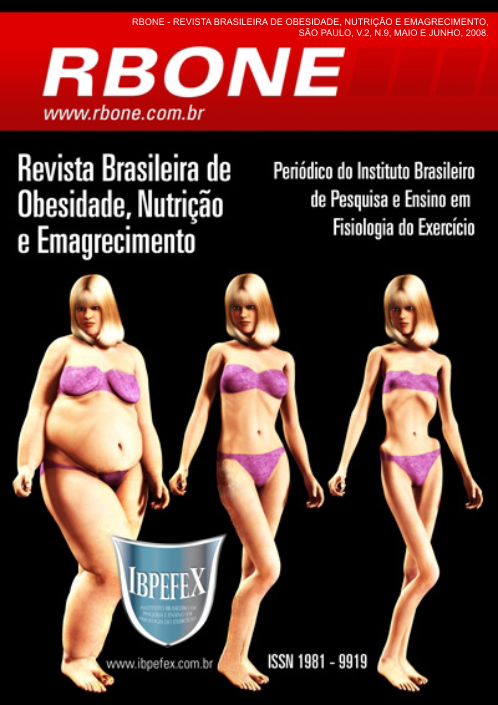Prevalence of excess weight and its relation to lunchtime eating habits for male and female full-time student adolescents at a technical school located in the southern area of the city of São Paulo-SP.
Abstract
The present study aims to verify the prevalence of excess weight and its relation to lunchtime eating habits for male and female full-time student adolescents at ETEC, a technical school located in the southern area of the city of São Paulo- SP. The number of subjects in the study, seventy, was selected in order to conform to previously established criteria. Weight and height data were obtained by an anthropometric evaluation and used in the calculation of body mass. The data on eating habits at lunchtime were obtained by questionnaire. The results show 21.4% of subjects with excess weight, with 20% overweight and 1.4%, predominantly males, being obese. Regarding eating habits, 68,6% of the sampling that was classified as underweight, overweight, or those otherwise within the normal weight (eutrophic) selected inadequately nutritious food. Based on the data, the resulting index of overweight subjects is even more worrisome when associated with inadequate choice of food by most of the adolescents. Eutrophic subjects who made the same poor choices present reason for concern since they might become overweight in the future. The study reinforces the necessity of school-based preventative strategies to promote habit change, with the goal of improving the health of these future adults.
References
- Almeida, Eliana C. Hábito do consumo do café da manhã por adolescentes estudantes de escolas publicas e privadas, localizadas na região central da cidade de Cotia-São Paulo. Tese (Mestrado). Universidade Federal de São Paulo – Escola Paulista de medicina, São Paulo, 2005.
- Andrade, R.G.; Pereira, R.A.; Sichieri, R. Consumo alimentar de adolescentes com e sem sobrepeso do município do Rio de Janeiro.Cad. Saúde Pública. Rio de Janeiro, RJ, v. 19, n. 5, p. 1485-1495, 2003.
- Anjos, L.A.; e colaboradores. Distribuição dos valores do índice de massa corporal da população brasileira até 25 anos. Revista Panamericana de Salud Pública. Washington, v. 3, n. 3, p. 164-173, 1998.
- Block e colaboradores. A data- based approach to diet questionnaire design and testing. American Journal of Epidemiology, v. 124, n. 3, p. 453- 469, 1986.
- Carvalho, C.M.R.G.; e colaboradores. Consumo alimentar de adolescentes matriculados em um colégio particular de Teresina, Piauí, Brasil. Revista de Nutrição. Campinas, v. 14, n. 2, p. 85-9, 2001.
- Cavadini, C. Hábitos alimentares durante a adolescência: contribuição dos lanches. In: A alimentação da idade pré-escolar até a adolescência. São Paulo, Nestlé, p. 14-6, 1995.
- Fisberg, M. Obesidade na infância e adolescência. São Paulo, Fundação BYK, 1995, 157 p.
- Garcia G.C.B.; Gambardella, A.M.D.; Frutuoso, M.F.P. Estado nutricional e consumo alimentar de adolescentes de um centro de juventude da cidade de São Paulo. Revista de Nutrição. Campinas, v. 16, n. 1, Jan./Mar, 2003.
- Gambardella, A.M.D.; Frutuoso, M.F.P.; Ferreira, C.F. Prática alimentar de adolescentes. Revista de Nutrição. Campinas, v. 12, n. 2, p. 55-63, 1999.
- Gatti, Raquel Rosalva. .Prevalência do excesso de peso em adolescentes de escolas públicas e privadas da cidade de Guarapuava- PR .2005. 84 p. Tese de mestrado – Pós-graduação em enfermagem em Saúde Pública, Universidade de São Paulo, Ribeirão Preto, 2005.
- Magalhães, V.C.; e colaboradores. Prevalência e fatores associados a sobrepeso e obesidade em adolescentes de 15 a 19 anos das regiões nordeste e sudeste do Brasil de 1996 - 1997. Cad Saúde Pública., Rio de Janeiro, v. 19, suppl 1, p. 129-39, 2003.
- Must, A.; Dallal, G.E.; Dietz, W.H. Reference data for obesity: 85 th and 95 th percentiles of body mass index. American Journal of Clinical Nutrition, v. 53, p. 839-846, 1991.
- Priore, S.E. Composição corporal e hábitos alimentares de adolescentes: uma contribuição à interpretação de indicadores do estado nutricional. Tese (Doutorado). Universidade Federal de São Paulo – Escola Paulista de medicina, São Paulo, 1998.
- Ramos M.; Stein L.M. Desenvolvimento do comportamento alimentar infantil. Jornal de Pediatria. Rio de Janeiro, v. 76, n. 8, p. 229-37, 2000.
- Salles, L.M.F. Adolescência, escola e cotidiano: contradições entre o genérico e o particular. Piracicaba, UNIMEP, 1998, 173p.
- Santos, G.V.B. Desnutrição e obesidade em pré-escolares da rede Municipal de Ensino de Ribeirão Preto.1997.151 p. Dissertação (Mestrado). Escola de Enfermagem de Ribeirão Preto- Universidade de São Paulo, Ribeirão Preto, 2003.
- Silva, E.L.; Menezes, E.M. Metodologia da pesquisa e elaboração de dissertação. 3ª ed. Florianópolis, Laboratório de ensino a distancia da UFSC, 2001, 21 p.
- Vitolo, Márcia R. Nutrição: da gestação à adolescência . Rio de Janeiro, Reichmann & Affonso Editores, 2003, 322 p.
- WHO (World Health Organization).Diet, nutrition and prevention of chronic diseases: reporto of a WHO study group. WHO Technical Report Series. Geneva, n. 797, p. 1-203, 1990.
Authors who publish in this journal agree to the following terms:
- Authors retain the copyright and grant the journal the right of first publication, with work simultaneously licensed under the Creative Commons Attribution License BY-NC which allows the sharing of the work with acknowledgment of the authorship of the work and initial publication in this journal.
- Authors are authorized to enter into additional contracts separately for non-exclusive distribution of the version of the work published in this journal (eg, publishing in institutional repository or book chapter), with acknowledgment of authorship and initial publication in this journal.
- Authors are allowed and encouraged to post and distribute their work online (eg, in institutional repositories or on their personal page) at any point before or during the editorial process, as this can bring about productive change as well as increase impact and impact. citation of published work (See The Effect of Free Access).






